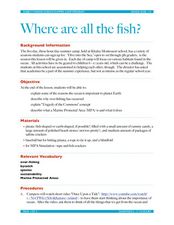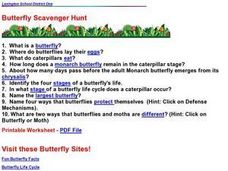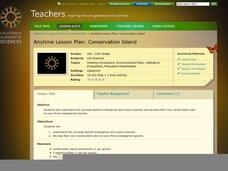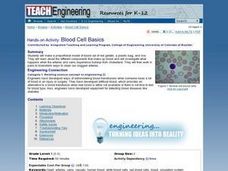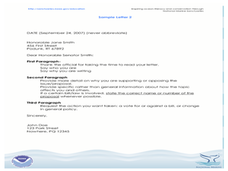Curated OER
Detroit Science Center Presentation
Students brainstorm what they learned while at the Detroit Science Center while the teacher records their thoughts on the whiteboard. They create a PowerPoint presentation using to the class using the information on the white board.
Curated OER
Investigating the Moon
Third graders explain why we study the moon. In this moon lesson, 3rd graders brainstorm and create a thinking web focused on what they know about the moon. Students complete a provided worksheet to organized their ideas about...
Curated OER
Sound
Students examine ways to produce sound. In this sound science instructional activity, students brainstorm ways to make sound and participate in several centers to demonstrate sound. An example of a center is using a clothes hanger and a...
Curated OER
Where Are All the Fish?
Students identify the problems that marine life is facing today. In this marine science instructional activity, students explain how Marine Protected Areas can help the ocean and the fish. They brainstorm ways to help in the conservation...
Curated OER
Dolphin Documentary
Students create a movie, out of paper, based on their knowledge of dolphin natural history. Students brainstorm what they know about dolphins and draw pictures of the dolphin facts. When the pictures are placed end to end they create a...
Curated OER
Go Fish! Fish or other Sea Creature from Recycled Materials
Students brainstorm what a fish looks like determining the parts from schema and research. They create a unique and interesting 3-d sculpture of fish or underwater creature mostly from recycled materials, then examine the aesthetics of...
Curated OER
Levers
Students brainstorm if they think that any lever would use the same amount of paperclips. They break into small groups and use a data sheet as well as a lever, Lego person, fulcrum, and some paperclips and prove what they think by taking...
Curated OER
Effects of Acid Rain
Third graders explore the concept of acid rain and its effects on ecosystems. They are placed in groups and using a graphic organizer they brainstorm their ideas about what would happen to the ecosystems living within these environments...
Curated OER
What Do You Know About Oceans?
Students brainstorm and discuss what they know about oceans and seas, read poem My Ocean Speaks by Olga Cossi, discuss narrator's feelings about ocean, write reflective journal entries about their experience or inexperience with the...
Curated OER
Living or Nonliving
Third graders brainstorm a list of the characteristics of living and nonliving organisms. Individually, they find four nonliving and living items and the characteristics that make them fit into one of the categories. To end the...
Curated OER
Animal Characteristics
Students create a graphic organizer to study animal characteristics. In this animal characteristics lesson plan, students use a program in Microsoft Word to create a brainstorm about different animal characteristics.
Curated OER
Concept Webs for the Components of a Coastline
Students describe the components of a coastline. In this lesson on coasts, students brainstorm the various features of a coastline.
Curated OER
Sea Turtle Savvy
Young scholars explore sea turtles. They create paper plate sea turtles and brainstorm other organisms that live in the sea turtle's habitat. They role-play scenes from a nonfiction book, A Baby Sea Turtle's Journey. They play a game...
Curated OER
Butterfly Scavenger Hunt
Learners, after brainstorming and discussing butterflies, answer a variety of key questions involving butterflies by participating in a butterfly scavenger hunt. They assess various butterfly facts, a butterfly's life cycle in detail and...
Curated OER
Landscape Picture Map
Students explore pollution of water sources. In this ecology lesson, students define and identify natural resources. Students use map skills to locate local rivers and lakes used for recreation. Students brainstorm ways in which to keep...
Curated OER
Scientific Method Experiment: Factors Affecting How Ice Melts
Students demonstrate the scientific method by conducting an ice cube melting experiment. They make predictions and observations, and conclude what factors make ice melt more slowly or quickly than normal.
National Geographic
Ocean Exploration
Dora, Dora, Dora, Dora, Dora! This may be your little ones' best guess as to what it's like to be an explorer! Give them a deeper understanding with this compact examination. A four-minute video introduces them to Robert Ballard,...
Curated OER
Flight for Survival - Avian Adaptations
Students create imaginary creature that has some of the adaptations birds have.
Curated OER
Life Cycle of a Monarch Butterfly
Students identify the stage of the butterfly's life cycle. In this life cycles lesson, students create a KWL chart about monarch butterflies. Students observe monarch caterpillars in an aquarium and identify the various stages of growth.
California Academy of Science
Poetic Reflections
Poetry is a wonderful way to explore language, express topical understanding, and incite creative thinking. After a trip to the local natural history museum (or zoo), learners write an acrostic or a cinquain poem describing one of their...
California Academy of Science
Conservation Island
Why not walk in the footsteps of Teddy Roosevelt and become a conservationist? After discussing issues and reasons for animal extinction, the class creates their own conservation plans. Each small group is given mock data regarding a...
Curated OER
Blood Cell Basics
Students design a proportional model of blood out of red gelatin, a plastic bag, and rice. They study the components that make up blood and investigate what happens when the arteries in different scenerios. They work in pairs in order to...
Curated OER
In My Opinion
Young writers craft letters to the government stating their opinion on different topics. They pick an environmental or ocean issue, research it, and craft their formal persuasive letter. Ensure your learners include supporting facts and...
Curated OER
Fossils 2: Uncovering the Facts
Students determine what types of information can be determined by looking at fossils. In this fossil instructional activity, students examine facts about and images of the Tyrannosaurus Rex at an assigned web site. They apply their...



